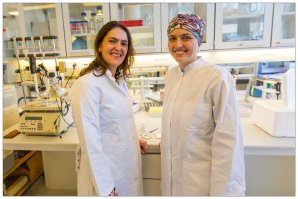Will we have stronger, enduring teeth? New material for tooth fillings is being investigated
Scientists used neutrons and X-rays to better understand the structure and hydration process of glass ionomer cements. This material is a promising alternative for dental fillings.
Inês Crespo, 19/03/2015

Heloisa Bordallo and Ana Benetti in the lab. © The Niels Bohr Institute – University of Copenhagen
Dental fillings are normally used to restore teeth, for instance after a cavity. However the materials currently in use need to be replaced often in patients who suffer from frequent cavities and they bind to the teeth through an adhesive that is rather vulnerable. A team of scientists from the University of Copenhagen are testing glass ionomer that could potentially be used as alternative for dental fillings.
Glass ionomer cements are an interesting option for dental fillings as they do not require an adhesive, they release fluoride which makes teeth healthier, and have good biological properties. Furthermore their preparation requires no special equipment or illumination, which is a big advantage in remote areas without electricity.

Preparation of glass ionomer cement. © The Niels Bohr Institute – University of Copenhagen
To better understand their structure and hydration process Heloisa Bordallo and Ana Benetti from the University of Copenhagen analysed two different cements. They have conducted X-ray experiments at the Helmholtz-Zentrum Berlin in Germany (HZB), and to better see the hydrogen atoms they used neutron scattering at the ISIS neutron source in the UK, the Institute Laue-Langevin in France and at HZB, the latter being funded by NMI3.
They then compared the images obtained from X-ray and neutron scattering to see whether the pores were dry or filled with liquid. The results suggest that the strongest material consists of cement powder mixed with a polyacid. The liquid binds faster to the cement, preventing free liquid to fill the pores. In fact glass ionomer cements could be stronger if we could control how the hydrogen atoms move within the material. By knowing this, the researchers can now infer on the material’s durability and investigate further.

This is still work-in-progress but it seems that in the future our smiles will show stronger, enduring teeth.
Original Publication
A.R. Benetti, J. Jacobsen, B. Lehnhoff, N.C.R. Momsen, D.V. Okhrimenko, M.T.F. Telling, N. Kardjilov, M. Strobl, T. Seydel, I. Manke & H.N. Bordallo (2015) How mobile are protons in the structure of dental glass ionomer cements? Scientific Reports, 5: 8972, DOI:10.1038/srep08972
NMI3 thanks Heloisa Bordallo for reviewing this article.
Materials taken from the University of Copenhagen press release .
Related articles
Heloisa Bordallo on our Women in Science pages
Heloisa Bordallo gave an interview for our Women in Science pages. Get to know all about her professional career here.
JRA Series: Imaging – Neutrons help visualising materials
New imaging methods will offer new possibilities to physicists, material scientists, engineers, palaeontologists, archaeologists, and others, so that they can obtain better information on their objects of study. See our video and article here !
SANS: a unique technique to look inside plants’ leaves
Small-angle neutron scattering enabled researchers to look inside intact leaves to learn how their structure and functions change when submitted to environmental changes. Read more Read more.




